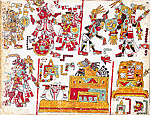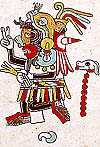

Introduction

Within the Special Collections of the University of Arizona Library are a number of quality facsimile editions of several manuscript paintings produced by the indigenous peoples of Mexico. The collection contains manuscripts both from before and after the Spanish Conquest that began in 1521. These manuscripts derive primarily from three cultural areas, Mixtec, Mayan, and Aztec, although they are not limited to them. The span of history these surviving codices cover is from A.D. 629 to 1642.
This web exhibit provides a brief representation of our collection with some bibliographic and historical information. Our goal was not a complete assessment of early Mexican manuscript painting, nor do we strive to represent any of the artifacts in their entirety. Rather, the exhibition serves as an introduction to these Mesoamerican codices and as a guide to finding these facsimiles in Special Collections. Therefore, bibliographic accuracy was more important for us than correct interpretation. Call numbers are also included with each codex.
The bulk of the facsimiles represented in this site are part of the Codices Selecti Phototypice Impressi series published by the Akademische Druck- u. Verlagsanstalt in Graz, Austria.

The Nature of the Codices
Only about two dozen pre-Columbian Mesoamerican codices have survived the book-burning policies of some native rulers and Spanish conquerors. Codices painted and written during the colonial period under Spanish supervision are more numerous. The number of Mesoamerican colored facsimile editions the University of Arizona Special Collections (both pre- and post-Conquest) is over thirty.
Although pre-Conquest Mesoamerican manuscripts are colloquially called "codices," they are actually screenfolds of long strips of leather (deerhide), cotton cloth or bark paper, occasionally protected by wooden covers. Throughout this exhibit, when referring to the manuscripts, we have retained the more familiar "codex" as well as other alternatives such as "manuscript," or "screenfold."
Mesoamerican codices produced before the European arrival fold like an accordion, often both obverse and reverse sides containing pictures. In cases when the screenfold was produced to be spread out on a wall, only one side was painted. The illustration below shows Codex Laud spread out like an accordion, with both sides painted. Click on the image to enlarge it.


Within a screenfold, each page is divided into either horizontal or vertical bands separated by bright red lines, which was read in a boustrophedon or back-and-forth fashion. In the image below from Codex Zouche-Nuttall, two adjacent pages are shown. The story is to be read from the bottom right, meandering along the path delineated by the red vertical lines across the other page, finally arriving in the left where the manuscript breaks off at the time of the European conquest.



In Mixtec codices, for instance, names of characters are represented by the date of their births. It is expressed by the image of the year they were born in (e.g. Rabbit, Skull, Deer, etc.) and the exact day represented by colored discs. The following glyph on the left describes the ruler 8 Deer: eight red discs are attached to a deer head. He was born on the eighth day of the year Deer. Another glyph at the bottom informs the reader that he was also known by the nickname Jaguar Claw. Nicknames were given at age seven, and these additional nickname glyphs are often incorporated into the costume.

The scribes noted the year in which an event took place with a sign similar to an interwoven A and O. The glyph on the right, for example, represents the year 2 Rabbit (A.D. 1066).

The Way this Exhibit is Organized
The majority of surviving Mesoamerican codices come from three cultural areas: Mixtec, Mayan and Aztec, and this distinction is employed the way this site is organized. There are codices included in each section that are either from a region other than these three or they are codices whose origin is unclear. Chronologically the codices are divided into pre-Conquest and early colonial codices. While surviving Mixtec codices are generally pre-Conquest, i.e. without European influence, surviving Aztec codices all exhibit European colonial influcences in their styles. Generally, if a codex was colonial, we have included it in the group of Aztec colonial manuscripts.
This exhibit features facsimiles available for viewing at Special Collections, and provides a brief bibliographic and historical description to each, as well as a number of scanned images. You will also find bibliographic references to other codices that are held at the library but are not featured in this exhibit.

A Note on Secondary Sources
Unless otherwise noted after a particular description, the companion volumes to the individual facsimiles served as sources to the commentaries. All facsimile images have been scanned from the particular editions under which they appear.
Enjoy the visit to our featured codices!

Home | Introduction | Featured Codices | Other Codices | Contact
Special Collections | UA Library | University of Arizona